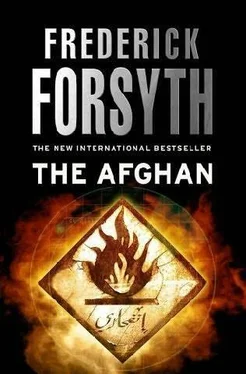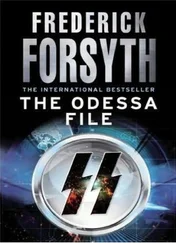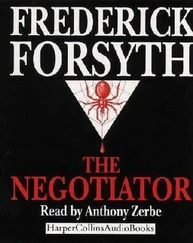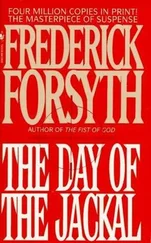Wei was not bothered with names or papers. It was shapes that concerned him. There would be parts of the Java Star to cut out and others to cut off. There would be features to be fashioned from welded steel. But most of all, he would create six long, steel sea containers that would occupy the deck from below the bridge to the forepeak in three pairs.
Yet they would not be real. From all sides, and from above, they would appear authentic down to the Hapag-Lloyd’s markings. They would pass inspection at a range of a few feet. Yet inside, they would have no interior walls; they would constitute a long gallery with a hinged, removable roof, and access through a new door, to be cut in the bulkhead below the bridge and then disguised to be invisible unless one knew the location of the release catch. What Mr. Wei and his team would not do was the painting. The Filipino terrorists would do that, and the ship’s new name would be applied after he had left. The day he fired up his oxyacetylene cutters, the Countess of Richmond was passing through the Suez Canal.
***
When Ali Aziz al-Khattab returned to the villa, he was a changed man. He ordered the shackles removed from his prisoner, and invited him to share his table at lunch. His eyes glittered with a deep excitement. “I have communicated with the sheikh himself,” he purred. Clearly, the honor consumed him. The reply was not written. It had been confided in the mountains to the messenger verbally, and he had memorized it. This is also a common practice in the higher reaches of Al Qaeda.
The messenger had been brought all the way to the Arabian Gulf, and when the Rasha docked the message had been given word for word to Dr. al-Khattab. “There is one last formality,” he said. “Would you please raise the hem of your dishdasha to the midthigh?”
Martin did so. He knew nothing of al-Khattab’s scientific discipline, only that he had a doctorate. He prayed it was not in dermatology. The Kuwaiti examined the puckered scar with keen attention. It was exactly where he was told it would be. It had the six stitches sutured into place in a Jaji cave eighteen years earlier by a man he revered.
“Thank you, my friend. The sheikh himself sends his personal greetings. What an incredible honor. He and the doctor remembered the young warrior and the words spoken.
“He has authorized me to include you in a mission that will inflict on the Great Satan a blow so terrible that even the destruction of the towers will seem minor.
“You have offered your life to Allah. The offer is accepted. You will die gloriously, a true shahid. You and your fellow martyrs will be spoken of a thousand years from now.”
After three weeks of wasted time. Dr. al-Khattab was now in a hurry. The resources of Al Qaeda down the entire coasts were called upon. A barber came to trim the shaggy mane to a Western-style haircut. He also prepared to shave off the beard. Martin protested. As a Muslim and as an Afghan, he wanted his beard. Al-Khattab conceded it could be clipped to a neat Vandyke around the point of the chin, but no longer.
Suleiman himself took full-face photos, and twenty-four hours later appeared with a perfect passport, showing the bearer to be a marine engineer from Bahrain, known to be a staunchly pro-Western sultanate. A tailor came, took measurements and reappeared with shoes, socks, shirt, tie and dark gray suit, along with a small valise to carry them. The traveling party prepared to leave the next day. Suleiman, who turned out to be from Abu Dhabi, would be going all the way, accompanying the Afghan. The other two were “muscle,” locally produced, locally recruited and dispensable. The villa, having served its purpose, would be scoured and abandoned.
As he prepared to leave before them, Dr. al-Khattab turned to Martin. “I envy you, Afghan. You can never know how much. You have fought for Allah, bled for Him, taken pain and the foulness of the infidel for Him. And now you will die for Him. If only I could be with you.” He held out his hand, English style, then recalled that he was an Arab and embraced the Afghan. At the door, he turned one final time. “You will be in paradise before me, Afghan. Save a place for me there.
Inshallah.”
Then he was gone. He always parked his hired car several hundred yards away and round two corners. Outside the villa gates, she crouched, as always, adjusting a shoe and glancing up and down the road. There was nothing but some chit of a girl two hundred yards up, trying to start a scooter that refused to fire. But she was local, in jilbab, covering the hair and half the face. Still, it offended him that a woman would have any motorized vehicle at all. He turned and walked away toward his car. The girl with the spluttering engine leaned forward and spoke into something inside the basket above the front mudguard. Her clipped English spoke of Cheltenham Ladies’ College. “Mongoose I, on the move,” she said.
***
ANYONE WHO has ever been involved in what Kipling called “the Great Game,” and what James Jesus Angleton of the CIA referred to as the “wilderness of mirrors,” will surely agree the greatest enemy is the UCU. The Unforeseen Cock-Up has probably wrecked more covert missions than treachery or brilliant counterintelligence by the other side. It almost put an end to Operation Crowbar. And it all started because everyone consumed by the new atmosphere of cooperation was trying to be helpful. The pictures from the two Predators that were “spelling” each other over the UAE and the Arabian Sea were going back from Thumrait to Edzell air base, which knew exactly why and American Army CENTCOM at Tampa, Florida, which thought the British had simply asked for some routine aerial surveillance. Martin had insisted that no more than twelve should ever know he was out in the cold, and the number was still only at ten. And they were not in Tampa. Whenever the Predators were over the Emirates, their images contained a teeming mass of Arabs, non-Arabs, cars, cabs, docks and houses. There were far too many to begin checking out every one. But the dhow called the Rasha, and her elderly master, were known about. So when she was docked, anyone visiting her was also of possible interest.
But there were scores. She had to be loaded and unloaded, refueled and reprovisioned. The Omani crewman scrubbing her down exchanged pleasantries with passersby on the quayside. Tourists wandered by to gawk at a real trading dhow of traditional teak. Her skipper was visited onboard by his local agents and personal friends. When a single, clean-shaven young Gulf Arab in white dishdasha and white, filigreed thub skullcap conferred with Faisal bin Selim, he was just one of many.
Edzell operations room had a menu of a thousand faces of confirmed and suspected AQ members and sympathizers, and every image from the Predators was electronically compared. Dr. al-Khattab did not trigger red flags because he was not known. So Edzell missed him. These things happen. The slim young Arab visiting the Rasha rang no bells in Tampa either, but the Army sent the images as a courtesy to the National Security Agency at Fort Meade, Maryland, and the National Reconnaissance Office-spy satellites-in Washington. The NSA provided them as a service to their British partners at GCHQ Gheltenham, who had a good, long look, missed al-Khattab and sent the images to the British Security Service-counterintelligence-more commonly known as MI5, at Thames House, just down the embankment from the Houses of Parliament. Here, a young probationer, keen to impress, ran the faces of all the visitors to the Rasha through the Face Recognition database. It is not all that long ago that the recognition of human faces relied on talented agents who worked in half darkness, poring over grainy images with magnifying glasses trying to answer two questions: Who is the man woman in this photo, and have we ever seen them before? It was always a lonely quest, and took years before a dedicated scrutineer developed the sixth sense that could recall that the “chummy” in the photo had been at a Vietnamese diplomatic cocktail party in Delhi five years earlier and was certainly for that reason from the KGCB.
Читать дальше










